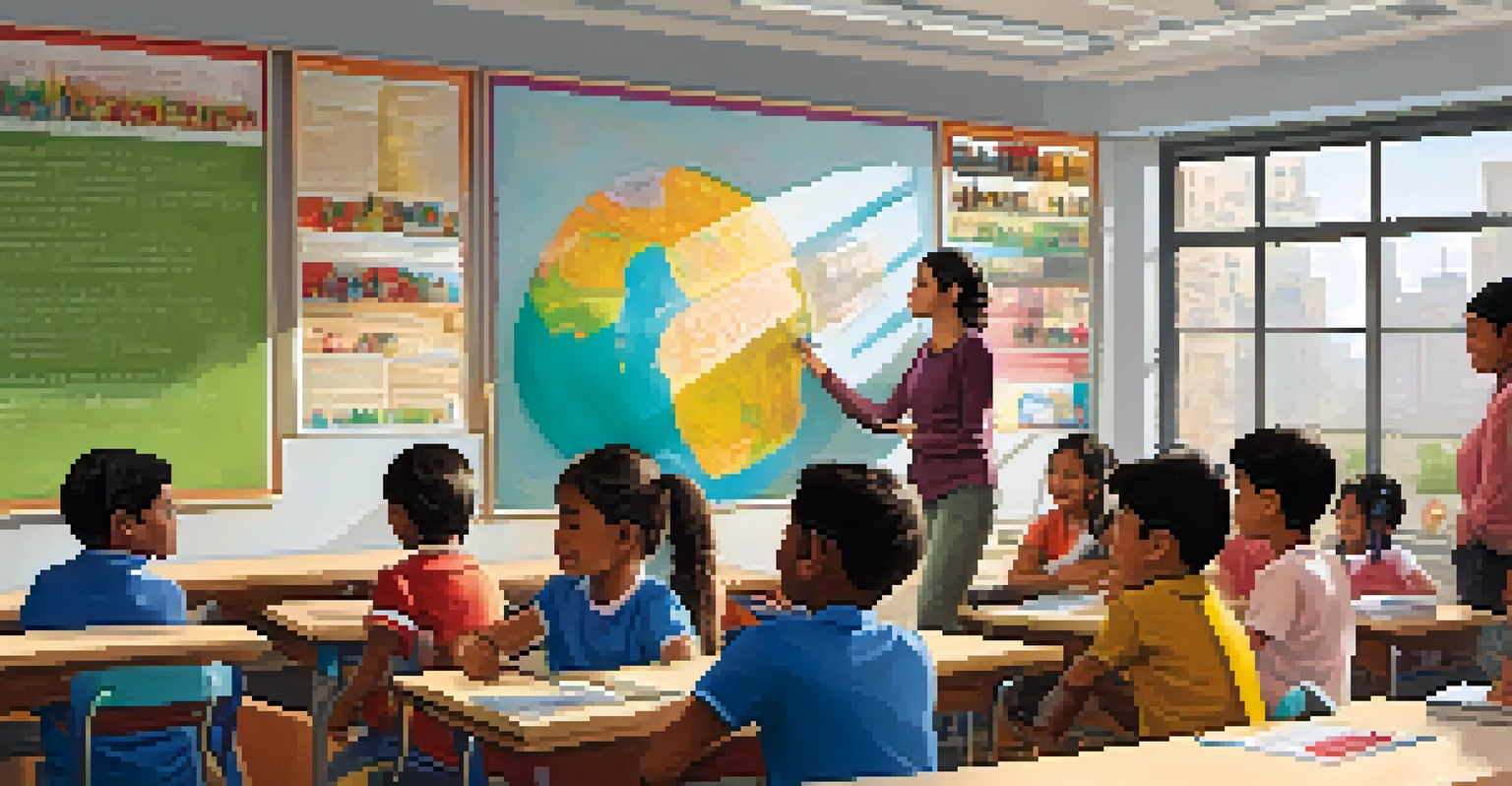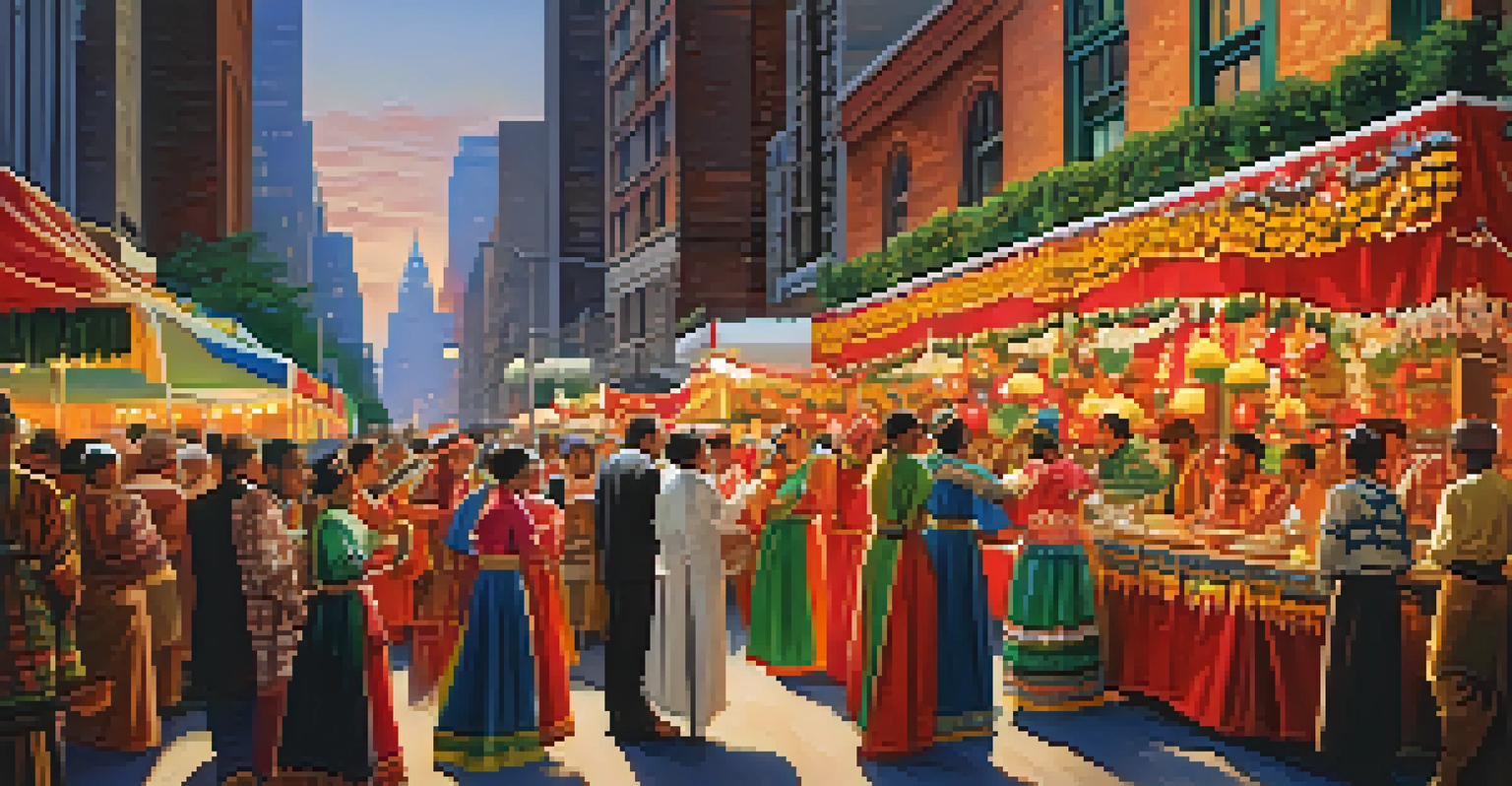Language Diversity: The Voices of New York State

The Melting Pot: New York's Linguistic Landscape
New York State is often referred to as a melting pot, and this is vividly reflected in its linguistic diversity. With over 200 languages spoken, it’s a true testament to the state’s rich immigrant history. From Spanish and Mandarin to Russian and Bengali, each language contributes to the cultural fabric of the state, making it a unique place to live and visit.
Language is the road map of a culture. It tells you where its people come from and where they are going.
This linguistic variety doesn’t just enrich our conversations; it also enhances our understanding of the world. Each language carries its own history and traditions, offering a glimpse into the lives of the communities that speak them. For instance, the presence of Haitian Creole reflects the vibrant Haitian community in Brooklyn, where the language is an integral part of daily life.
Moreover, language diversity in New York promotes inclusivity, allowing for greater connections among people from different backgrounds. It encourages dialogue and understanding, fostering a sense of belonging among residents. As we navigate this diverse landscape, it’s essential to appreciate the voices that shape our collective experience.
The Role of Education in Promoting Language Diversity
Education plays a crucial role in preserving and promoting language diversity in New York. Schools across the state are increasingly recognizing the importance of bilingual education programs, which not only benefit English language learners but also enrich the entire student body. By integrating multiple languages into the curriculum, students gain a deeper appreciation for different cultures.

In New York City, for example, dual language programs allow students to learn in both English and another language, such as Spanish or Mandarin. This approach not only helps non-native speakers but also equips all students with valuable communication skills in our globally interconnected world. The ability to speak more than one language is a significant asset in today’s job market.
New York's Rich Language Diversity
New York State's linguistic landscape features over 200 languages, reflecting its vibrant immigrant history and cultural richness.
Additionally, local community centers and libraries offer language classes and cultural events that celebrate linguistic diversity. These initiatives create opportunities for people of all ages to engage with different languages, fostering a sense of community and mutual respect. By prioritizing language education, New York can cultivate a more inclusive society.
Cultural Celebrations: Festivals and Events Highlighting Diversity
New York State is home to numerous festivals and events that celebrate its linguistic diversity, showcasing the vibrant cultures that exist within its borders. One such event is the New York City International Salsa Congress, which brings together dancers and musicians from around the world to honor the Spanish language and Latin culture. These gatherings not only entertain but also educate attendees about the richness of different traditions.
The limits of my language mean the limits of my world.
Another example is the annual Queens World Film Festival, which features films in various languages, reflecting the borough's diverse population. By showcasing stories from different cultural perspectives, these films help to foster understanding and appreciation among viewers. Such events act as a reminder of the power of storytelling and its ability to bridge cultural divides.
These celebrations also provide a platform for underrepresented voices to be heard, allowing communities to express their identities and share their heritage. As attendees participate in workshops, performances, and discussions, they become more aware of the languages and cultures that shape their neighbors’ lives. This kind of cultural exchange is invaluable in promoting tolerance and acceptance.
Challenges Faced by Minority Language Speakers
Despite the rich tapestry of languages in New York, many minority language speakers face significant challenges. One major issue is the lack of resources available for non-English speakers, which can hinder their access to education, healthcare, and employment opportunities. This often leads to feelings of isolation and marginalization within their communities.
Furthermore, the dominance of English can create pressure for individuals to assimilate, resulting in the gradual decline of their native languages. Many young people, especially, may feel compelled to abandon their heritage languages to fit in with their peers. This linguistic shift can lead to a loss of cultural identity and heritage, which is deeply concerning for many communities.
Education Fosters Language Skills
Bilingual education programs in schools promote language diversity, benefiting both English learners and the entire student body.
Efforts to combat these challenges are underway, with advocacy groups working to promote language rights and access to resources for minority language speakers. By raising awareness and providing support, these organizations aim to empower individuals to preserve their languages and cultural identities. It’s crucial for society to recognize the value of linguistic diversity and work towards creating a more inclusive environment for all.
The Importance of Language Preservation Initiatives
Language preservation initiatives are vital for maintaining the cultural richness of New York State. Organizations like the Endangered Language Fund work to document and revitalize languages that are at risk of disappearing. These efforts ensure that future generations have the opportunity to learn and connect with their heritage.
Local community groups also play a significant role in language preservation by offering classes, workshops, and cultural events. For example, the New York Language Conservancy promotes indigenous languages through various programs, fostering a sense of pride among speakers and learners alike. These initiatives create spaces where language can thrive, encouraging intergenerational transmission.
Moreover, technology has opened new avenues for language preservation, with apps and online resources making it easier for individuals to learn and practice their languages. As digital tools become more accessible, they can help bridge the gap between generations, ensuring that languages continue to be spoken and celebrated in homes and communities.
The Impact of Technology on Language Diversity
Technology has significantly influenced language diversity in New York State, reshaping how people communicate and learn languages. Social media platforms, for instance, provide spaces for speakers of various languages to connect and share their cultural experiences. This virtual interaction fosters a sense of community among speakers, regardless of geographical barriers.
Additionally, language learning apps and online courses have made it easier than ever for individuals to learn new languages at their own pace. Many people in New York are taking advantage of these tools, embracing the opportunity to explore languages like Arabic, Korean, or Polish. Such resources not only promote language acquisition but also encourage cross-cultural understanding.
Challenges for Minority Languages
Many minority language speakers face significant challenges, including resource scarcity and pressure to assimilate, threatening their cultural identities.
However, it’s essential to recognize that technology can also pose challenges to language diversity. The prevalence of dominant languages online can overshadow minority languages, leading to a decline in their use. It’s crucial for communities to advocate for the inclusion of diverse languages in digital spaces, ensuring that all voices are heard and valued.
The Future of Language Diversity in New York
Looking ahead, the future of language diversity in New York State appears promising, thanks to the ongoing efforts of community members, educators, and advocates. As demographics continue to shift, the state will likely see an even broader range of languages being spoken. This evolution presents an opportunity to celebrate and embrace the rich cultural tapestry that defines New York.
Moreover, initiatives aimed at promoting multilingualism are gaining traction, with schools and organizations recognizing the value of bilingual and multilingual programs. By investing in these programs, New York can equip its residents with the skills needed to thrive in a globalized world, enhancing both personal and professional opportunities.

Ultimately, the continued celebration and preservation of language diversity will depend on collective efforts from all corners of the community. By supporting one another and valuing the unique voices that contribute to New York’s identity, we can ensure that the state remains a vibrant hub of cultural exchange and understanding for generations to come.